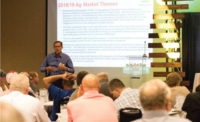Bull Market
by Lynn Petrak
Special Projects Editor
Special Projects Editor
Despite safety scares and high prices, consumers have no beef with a favorite protein.
From domestic cases of bovine spongiform encephalopathy (BSE) to the growing number of carbohydrate-counting consumers to continued processor consolidations, the beef category has experienced plenty of ups and downs lately.
“On a personal note, I have seen a more rapid change in the beef industry on a yearly basis than I have in my entire thirty-plus year career in this industry,” observes Mark Thomas, vice president, global marketing for the National Cattlemen’s Beef Association (NCBA), Centennial, CO, citing market factors and aggressive industry initiatives.
Research from the U.S. Department of Agriculture (USDA) relays per capita consumption of beef rose from 62.9 percent to 64.2 percent from 2001 to 2002, the most recent statistics available. Figures from The FreshLook Marketing Group, Hoffman Estates, IL, shows that consumer purchases of retail beef increased 3.14 percent from March 2003 to March 2004, to reach total dollar sales of $13.1 billion and to lead other proteins like chicken and pork.
For cattle producers and beef processors, it’s been an unusual period, marked by high prices and high demand. Dave Weaber, director of research and special projects for Centennial, Co-based Cattle-Fax, says preliminary data for the first quarter of 2004 suggests that beef demand was up about 11 percent compared to a year earlier, while beef production declined about 7 percent for the same time frame. “Remember that price is a function of both supply and demand. As supplies got shorter prices went higher to ration use — this price increase was further fueled by stronger demand,” he explains.
BSE impact
Economics aside, arguably the biggest story to impact the market has been the isolated cases of BSE, which first erupted in December 2003 and cropped up in headlines again this summer. “While the presence of BSE in this country has resulted in increased consumer awareness about the disease, recent checkoff-funded consumer surveys indicate consumers have received the information they need to understand that the beef supply in the United States remains the safest in the world,” notes Thomas.
Likewise, Patrick Boyle, president and chief executive officer of the American Meat Institute (AMI), Washington, DC, says that the industry’s proactive steps have been effective.
“We’ve been working for over a decade to ensure that the U.S. would never fall prey to a major BSE outbreak, as was experienced in Europe. We’ve not only taken steps to ensure that the disease doesn’t spread in our herds, but to ensure that the meat supply is completely safe from BSE. American consumers know this, which explains why consumer confidence in beef, and consequently demand for beef, is so high,” he remarks.
As they work through food safety and animal health issues, beef processors continue to develop innovative, value-added cuts like fully-cooked entrées and “flat-iron” steaks to consumers, who are having other positive reactions to beef.
“Without a doubt, the high and moderate protein diet revolution has helped the consumer market for beef,” says Thomas. “However, we should not attribute all of this success to any particular diet — the demand craze is a result of an industry-wide effort.”


Report Abusive Comment